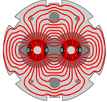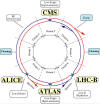 |
LHC Vacuum system |
 |
||||||
Ultrahigh beam vacuum 10-10 Torr (~3 million molecules/cm3) , we want to avoid collisions with gas molecules In space the pressure decreases with the altitude from the pressure of 760 Torr at sea level. Up to 100 km altitude (troposphere and stratosphere) the pressure decreases quite regularly by a factor of 10 per 15 km altitude, which results in a pressure of 10-3 Torr at about 90 km altitude. The ionosphere (100-400 km) contains a large number of ionized atoms, and its pressure decreases only by a factor of 10 every 100-200 km. This decrease results in a pressure of about 10-10 Torr at an altitude of 1,000 km. At 10,000 km the pressure is about
10-13 Torr. The pressure measured on space crafts are
determined by the spacecraft velocity and gas particle concentration. Distance to moon: 380,000 km LHC has the particularity of having not one, but three vacuum systems: (from LHC design report:
one sees around 9000 m^3 for the cryomagnet insulation vacuum and 5000 m^3 for the QRL.) Vacuum - MaterialsThe cold bore tubes of the dipole magnets are seamless non-magnetic austenitic steel tubes 15.6 m long. The insulated cold bore tubes are placed in the aperture of the coils and form part of the inner wall of the helium vessel that contains the active part of the magnet. The cold bore tube is the passage for the circulating particle beams and as such, the tube wall separates the helium volume from the beam vacuum. Main characteristics of the bare cold bore tubes for the main
LHC dipoles & SSS Beam screen which sits inside the cold bore tubes: The manufacturing process
starts by co-laminating a specially developed low permeability 1mm thick austenitic
stainless steel strip with a 75 µm copper sheet and rolling
a saw-tooth structure which will The baseline for the room temperature (RT) beam vacuum system is to use 7
m long OFS copper chambers, with an inner diameter of 80 mm and fitted with
standard DN100 Conflat™ flanges. The thickness of the copper is 2 mm and the
chambers are coated with TiZrV non evaporable getter (NEG) [17], which after
activation at low temperature (200°C) provides distributed
pumping and low outgassing to maintain a low residual gas pressure, as well
as a low secondary electron emission yield to avoid electron Full details in chapter 12 of the LHC design report. Units1 Torr is the pressure that supports 1 mm of mercury or 1 mmHg. Normal atmospheric pressure is defined as 1 atmosphere. 1 atm = 760 torr. In SI units 1 pascal (Pa) = a force of 1 Newton per square meter 1 bar = 100,000 Pa 1 millibar = 0.001 bar = 100 Pa = 0.750 torr 1 atm = 101,325 Pascals = 760 mm Hg = 760 torr.
|
||||||||